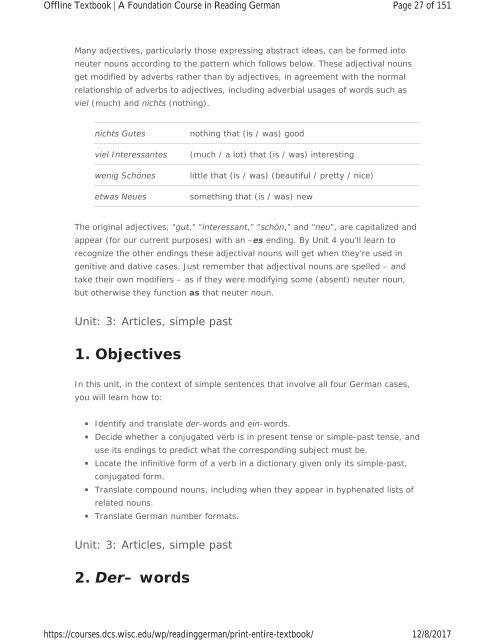A Foundation Course in Reading German, 2017a
A Foundation Course in Reading German, 2017a
A Foundation Course in Reading German, 2017a
You also want an ePaper? Increase the reach of your titles
YUMPU automatically turns print PDFs into web optimized ePapers that Google loves.
Offl<strong>in</strong>e Textbook | A <strong>Foundation</strong> <strong>Course</strong> <strong>in</strong> Read<strong>in</strong>g <strong>German</strong><br />
https://courses.dcs.wisc.edu/wp/read<strong>in</strong>ggerman/pr<strong>in</strong>t-entire-textbook/<br />
Page 27 of 151<br />
12/8/2017<br />
Many adjectives, particularly those express<strong>in</strong>g abstract ideas, can be formed <strong>in</strong>to<br />
neuter nouns accord<strong>in</strong>g to the pattern which follows below. These adjectival nouns<br />
get modified by adverbs rather than by adjectives, <strong>in</strong> agreement with the normal<br />
relationship of adverbs to adjectives, <strong>in</strong>clud<strong>in</strong>g adverbial usages of words such as<br />
viel (much) and nichts (noth<strong>in</strong>g).<br />
nichts Gutes<br />
viel Interessantes<br />
wenig Schönes<br />
etwas Neues<br />
noth<strong>in</strong>g that (is / was) good<br />
(much / a lot) that (is / was) <strong>in</strong>terest<strong>in</strong>g<br />
little that (is / was) (beautiful / pretty / nice)<br />
someth<strong>in</strong>g that (is / was) new<br />
The orig<strong>in</strong>al adjectives, “gut,” “<strong>in</strong>teressant,” “schön,” and “neu”, are capitalized and<br />
appear (for our current purposes) with an –es end<strong>in</strong>g. By Unit 4 you’ll learn to<br />
recognize the other end<strong>in</strong>gs these adjectival nouns will get when they’re used <strong>in</strong><br />
genitive and dative cases. Just remember that adjectival nouns are spelled – and<br />
take their own modifiers – as if they were modify<strong>in</strong>g some (absent) neuter noun,<br />
but otherwise they function as that neuter noun.<br />
Unit: 3: Articles, simple past<br />
1. Objectives<br />
In this unit, <strong>in</strong> the context of simple sentences that <strong>in</strong>volve all four <strong>German</strong> cases,<br />
you will learn how to:<br />
Identify and translate der-words and e<strong>in</strong>-words.<br />
Decide whether a conjugated verb is <strong>in</strong> present tense or simple-past tense, and<br />
use its end<strong>in</strong>gs to predict what the correspond<strong>in</strong>g subject must be.<br />
Locate the <strong>in</strong>f<strong>in</strong>itive form of a verb <strong>in</strong> a dictionary given only its simple-past,<br />
conjugated form.<br />
Translate compound nouns, <strong>in</strong>clud<strong>in</strong>g when they appear <strong>in</strong> hyphenated lists of<br />
related nouns.<br />
Translate <strong>German</strong> number formats.<br />
Unit: 3: Articles, simple past<br />
2. Der– words


















